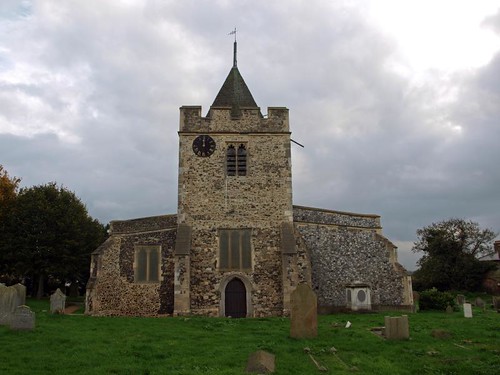ST MICHAEL. Low W tower, low flat-roofed N aisle, higher N chancel chapel. All windows renewed. The building history begins with the one unsplayed early C12 window inside the nave close to the E end of the N arcade. Later in the C12 the three-bay S arcade was made with broad piers of Greek cross section. The two E bays have one-stepped arches, the W bay instead a double-chamfered arch. In the E respond a C14 niche. The N arcade with circular piers and double-chamfered arches is C13, as are the N chancel chapel of two bays and the W tower with angle buttresses and a single-chamfered tower-arch. - FONT. C12, the Purbeck type often met with: square bowl decorated with shallow blank round arches; five supports. - PULPIT with tester, the Elizabethan-Jacobean type; dated 1621. - SCREEN between chancel and nave, C15, uninteresting. - PLATE. Cup and Cover of 1620; Almsdish of the late C17. - MONUMENTS. Important Brass to Ralph de Knevynton d. 1370; Flemish. Rectangular plate with thin buttresses and traceried spandrels. - Brass to the Bacon children, 1588. - Epitaph to Elizabeth Bacon d. 1583, brass of infant in swaddling clothes under Purbeck marble arch.
AVELEY. It has treasures of every age in its church, frrom the arcaded Norman font to craft work of our time. It is thrilling to see the Roman tiles picked up by the Saxons and used again by the Normans in these flint walls.
The Normans built the nave, and their round arches face the pointed arches of the first English builders. The tower is 13th century but its dwarf spire is modern. A Norman pillar piscina is sunk in the chancel wall under a carved recess of the 15th century, and the woodworkers of the next century gave the church its splendid screen. It has five openings with traceried heads on each side of the entrance to the chancel. In front are three other beautiful things in wood; the pulpit, the lectern, and a tiny prayer desk. The six-sided pulpit, dated 1621, has arches on its panels, and high above it hangs a great sounding-board, also six-sided and wondrously carved. The beautiful lectern was carved in ancient oak from Winchester. The litany desk was given in 1916 by the Sussex Regiment, “for blessings received during their stay in the parish.” An elaborate chair of 1620 is crowned with the Dacre crest. On the altar front are three paintings by Sir Charles Holroyd, famous as a forceful etcher and a Director of our National Gallery; the blue dress of the Madonna is of exquisite texture, and the adoring shepherds are natural figures.
A stone with a raised cross was probably the coffin lid of Nicholas de Belhus, brought to rest here from the manor house next door. A Flemish brass shows Ralph de Knevynton under a canopy of rich design, his feet on a dog with a collar; it is odd to see him at prayer with a sword. He has been here since 1370, and his armour is of great value to students. There is a tiny 16th century brass in memory of the infant daughter of Edward Bacon. Inscriptions record the burials of the Barretts and the Dacres, who lived in Belhus, the magnificent 16th century home in a park three miles round. The side of the house which faces Aveley, and the gatehouse tower behind, are noble examples of Tudor architecture.
The Normans built the nave, and their round arches face the pointed arches of the first English builders. The tower is 13th century but its dwarf spire is modern. A Norman pillar piscina is sunk in the chancel wall under a carved recess of the 15th century, and the woodworkers of the next century gave the church its splendid screen. It has five openings with traceried heads on each side of the entrance to the chancel. In front are three other beautiful things in wood; the pulpit, the lectern, and a tiny prayer desk. The six-sided pulpit, dated 1621, has arches on its panels, and high above it hangs a great sounding-board, also six-sided and wondrously carved. The beautiful lectern was carved in ancient oak from Winchester. The litany desk was given in 1916 by the Sussex Regiment, “for blessings received during their stay in the parish.” An elaborate chair of 1620 is crowned with the Dacre crest. On the altar front are three paintings by Sir Charles Holroyd, famous as a forceful etcher and a Director of our National Gallery; the blue dress of the Madonna is of exquisite texture, and the adoring shepherds are natural figures.
A stone with a raised cross was probably the coffin lid of Nicholas de Belhus, brought to rest here from the manor house next door. A Flemish brass shows Ralph de Knevynton under a canopy of rich design, his feet on a dog with a collar; it is odd to see him at prayer with a sword. He has been here since 1370, and his armour is of great value to students. There is a tiny 16th century brass in memory of the infant daughter of Edward Bacon. Inscriptions record the burials of the Barretts and the Dacres, who lived in Belhus, the magnificent 16th century home in a park three miles round. The side of the house which faces Aveley, and the gatehouse tower behind, are noble examples of Tudor architecture.

No comments:
Post a Comment